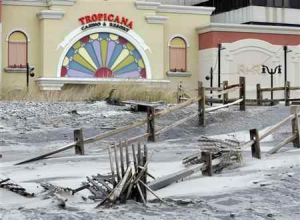Nothing has afflicted the United States quite like Sandy did in decades. The hurricane cost a tallied damage amounting to $20 billion on properties and $30 billion on businesses. Such a loss is, no doubt, huge. In fact, it is considered the one of the costliest in all of US history. It did not only affect US but as well as the neighboring countries like Canada, Cuba, Haiti, Bahamas, Dominican Republic, Bermuda and Jamaica. Surely, because of the devastating effect of Sandy, many have not yet recovered.

Hurricane Sandy Aftermath in Atlantic City
Image Source: International Business Times
Businesses in the affected areas, both big and small have been greatly affected by the disaster. Steve Bidgood, owner of Salt Creek Grille has never seen the water rise over the banks of Navesink River straight to his restaurant, soaking the first floor. Mike Pimco, owner of Pimco’s Style Rocket, a clothing store located at Fifth and Ocean avenues on Asbury Park’s boardwalk, had a business left with an ankle deep of muck and sand mixed. “My hope is that it isn’t so much a financial burden that we can clean up and come back in the spring,” said Pimco, who was painstakingly shoveling the muck and sand in his store into a wheelbarrow. “There’s a lot of work to be done over the winter months to prepare for the busy season.” What happened to them are just two examples of the many small businesses along the coasts that have been affected by Sandy. This made them realize that although the location could attract a lot of customers, they could also be easily wiped out by the acts of nature.
Businesses located in the cities were no excuse. The owner of Gowanus Nursery located in Brooklyn, Michele Paladino, said she hoped to ride out the storm at the nursery Monday night. However, the seawater flooded the basement of the store that caused the shot circuiting of an electrical box. After few hours, the high winds blown down the 12-foot fence in front of her store. There would be a lot of cleaning to do for her. But more than that is the cost of the damage to her business.
Small businesses are probably one of the most vulnerable in times of disaster. It is thus important that owners of these types of businesses should be able to prepare for the unexpected. There has to be a development of a disaster plan in each and every small business so as to make solid its foundations. We are aware that small businesses don’t have the wealth of resources to program a comprehensively perfect disaster plan. But this is not a reason why there shouldn’t be any.
The following are five fundamental steps towards developing an effective disaster plan suggested by Houston Chronicle:
Identification
The types of disaster that could possibly harm the business have to be first identified. Disasters could take a lot of forms. It could climate disasters just like Sandy. It could also be floods and fires, or technological disasters that can wipe out entire computer systems. It is important to identify them because it is only through identification that the sensing process could be done. The sensing process involves developing early warning systems like softwares, gadgets or sensors.
Creating Business Continuity Plans
Business Continuity Plans or Business Recovery Plans, as defined in the article, “are documents that companies use a guide to keep things orderly in the event of a disaster, ensure the safety of employees and help with business continuity in post-disaster circumstances to minimize corporate setbacks, according to the U.S. Federal Emergency Management Agency.” These plans assess what the business needs to do to sustain its life and keep it operating, what it needs to have and who will do certain tasks.
Protecting Finances, Records and Equipment
Documents and equipment are two of the most important things that a business needs to safeguard. The destruction of equipment could temporarily or permanently stop business operations, depending on the extent of destruction or the cost of the equipment The lost of documents of business could mean the death of a business. It then has to be included in a business’ Business Continuity Plans. If the documents are in papers, then it has to be placed in a very secure place. Duplicates would also be a good idea. For documents in soft copies, an online storage would be best. Anyway, documents wouldn’t take so much space so free storage services would do.
Keeping Employees Safe
Employee’s safety is something that business owners have to perfectly assure. Business owners must be able to plan out evacuation processes with respect to whatever disaster may happen. An evacuation site should already be secured. But it doesn’t stop there. The employees have to know about the process and they should also be trained to make themselves familiar of the process so as to get rid of panicking and whatever problem that it could cause.
Communication Planning
Communication has to be protected in business, most especially in times when disaster happens. It has to be carefully considered because many things can happen in a disaster; the source of power could be cut out. So, in addition to the conventional means of communication that businesses use in day-to-day operations, alternative means have to be secured. Without communication planning, a business’ entire disaster plan could come to naught.
“Prevention is better than cure,” as the famous quote goes. Disasters may be inevitable sometimes, such as Hurricane Sandy’s case. But a carefully developed disaster plan could minimize the damages.
